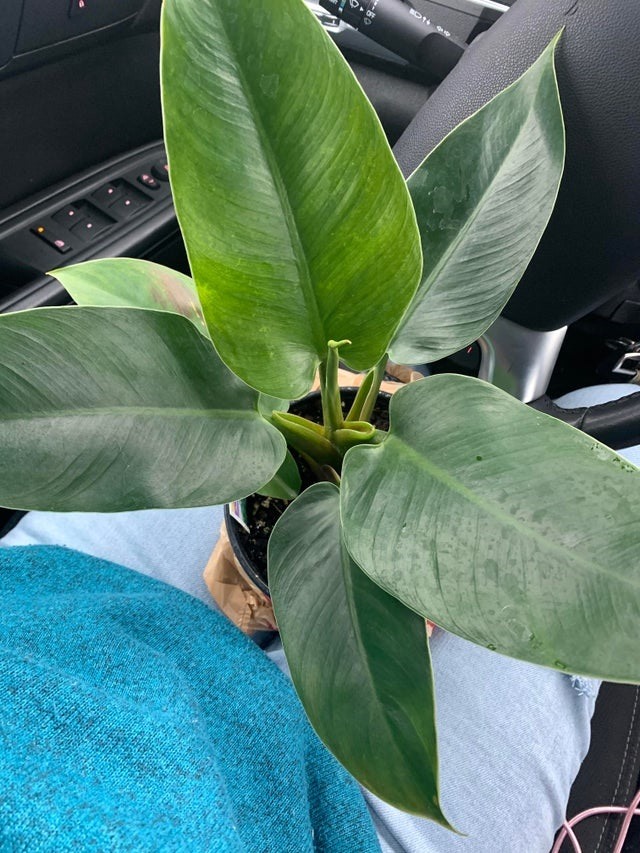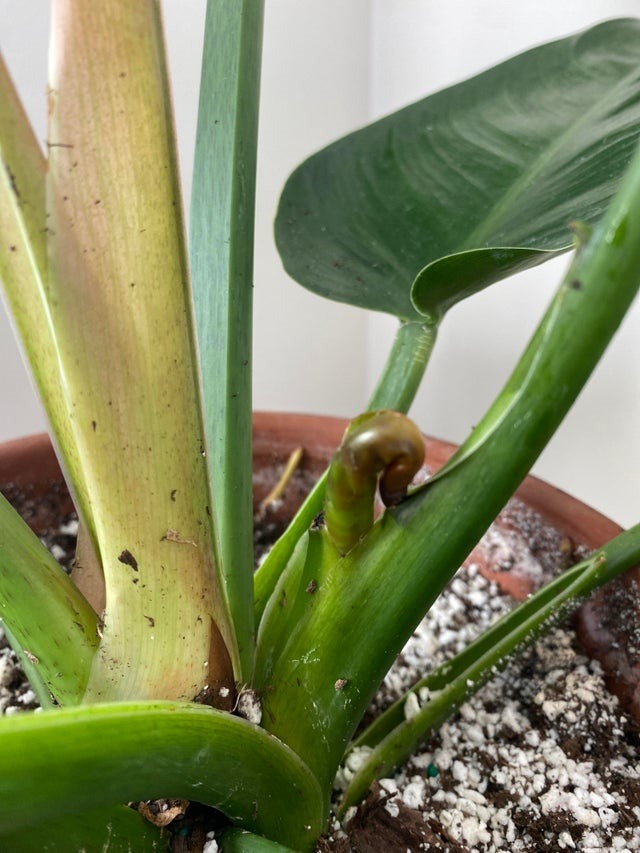Philodendron imperial green is a fantastic houseplant. Thanks to its large, stiff, glossy, and lush leaves that bring out a lasting impression. This non-vining philodendron is readily available, inexpensive, and looks brilliant.
Philodendron imperial green care involves the provision of bright indirect sunlight, moderate humidity, regular watering, and a temperature range of 60-85oF (16-30oC). Feeding the houseplant every month during spring and summer is essential.
Read on to learn how to care for the philodendron imperial green plant like a professional. The guide also provides common philodendron imperial green problems and their respective solutions.
You Might Also Like: How to Care for Philodendron Birkin

What Does Philodendron Imperial Green Looks Like?
Imperial green is one of the philodendron varieties with a striking appearance. This luscious houseplant is easy to grow and maintain throughout the year.
The indoor plant derived its name from the smooth and glossy foliages. The large leaves fan out in all directions to bring a tropical feeling at home.
The imperial green is similar to philodendron imperial red, prince of orange, and Rojo congo in care requirements.
But this self-heading philodendron species stay compact with its impressive leaves size. Proper imperial green care routines will keep this plant happy and healthy forever.
Besides that, imperial green is the only philodendron species that help to purify air at home or office to foster healthy living and working condition.
Keep reading this imperial green philodendron care to learn everything associated with this houseplant. The information will help you stand out from other season growers.
You May Also Read: How to Care for Philodendron Brasil
Philodendron Imperial Green Care Details
| Origin | Native to Colombia |
| Scientific Name | Philodendron imperial green |
| Common Name | Sweetheart plant |
| Imperial Green Philodendron Size | Around 90-120cm tall |
| Light Requirements | Bright indirect sunlight. Direct sunlight might scorch the leaves. |
| Watering Needs | Moderate soil moisture. Imperial green does not tolerate a damp environment. |
| Soil Type | Well-draining soil with a better moisture holding capability. |
| Temperature Range | 60-85oF (16-30oC) |
| Feeding Requirements | Apply fertilizer every month during spring and summer. |
| Humidity Level | 40-60% humidity level maintenance. The plant will also tolerate low humidity due to the glossy leaves. |
| Pruning | Low to none. Remove dead or damaged leaves. |
| Propagation | Stem cuttings in water or soil. |
| Repotting | Recommendable due to root-bound issue |
| Pests and Diseases | Pests: Spider mites and aphids. Diseases: Bacterial Blight and leaf spot |
| Bloom | Does not produce flowers |
| Toxicity | Relatively toxic to humans and pets |
How to Care for Philodendron Imperial Green Plant
Philodendron Imperial Green Light Requirements
Imperial green philodendron thrives well in bright indirect sunlight. I recommend placing the houseplant near the window with curtains or shears.
Avoid direct sunlight since it will cause leaves to scorch and ruin the general appearance of your philodendron species. Excess direct sunlight might also cause plant wilting.
Low light conditions foster stunted growth and increase the risk of overwatering. Change the current location of your plant if it is not producing new leaves.
How to Water Philodendron Imperial Green
Watering is an essential imperial green philodendron care after lighting. A proper watering regime will keep the plant healthy and happy throughout the year.
Philodendron imperial green loves moderate soil moisture to thrive. Allow the potting medium to dry between the watering. Too much moisture content increases the risk of overwatering issues.
Insert the index finger in the topsoil to determine the moisture content. If the potting soil is dry, soak it with rainwater or distilled water until the water runs through the drainage holes.
Avoid sticking to a strict watering schedule when growing philodendron imperial green at home or office. Both overwatering and under-watering may cause harm to the houseplant.
Best Water for Philodendron Imperial Green
Water and light are crucial components for growing imperial green philodendron. But water quality matters a lot to enhance happiness and healthy growth.
Imperial green foliages are not too sensitive to impurities like fluorides and chlorine. Excessive accumulation of these impurities might cause brown leaf tips and edges.
Rainwater and distilled water have no impurities. I recommend switching from tap water to either rainwater or distilled water.
Philodendron Imperial Green Soil Requirements
Imperial green flourish in light and well-draining soil. Heavy and compact soil hinders water drainage and root aeration.
Use potting soil with adequate aeration and retain water to prevent the houseplant from wilting or drying up. I recommend going for an aroid mix for your imperial green plant.
Another excellent option is to mix houseplant potting soil with perlite. Add coco coir to increase aeration and organic matter to boost soil fertility.
Read my article on How to Make Homemade Fertilizer for Houseplants. The information will help you to avoid the use of artificial fertilizer and save on costs.
Philodendron Imperial Green Humidity Requirements
Imperial green philodendron is tolerant to low humidity than other indoor plants. But the houseplant thrives well when the indoor humidity level is about 40-60%.
Low indoor humidity causes imperial green foliages to curl or turn brown at the tips and edges. I recommend monitoring the indoor humidity changes to avoid such problems.
Use a digital hygrometer (Check the Best Deals on Amazon) to track the indoor humidity level. Another option is to group your indoor plants to boost humidity.
Temperature Range for Philodendron Imperial Green
Growing philodendron imperial green indoors can be challenging due to temperature dynamics throughout the year. Maintain a temperature of 60-85oF (16-30oC) for a successful result.
Any temperature below 60oF (16oC) will cause stunted growth. The cold damage might also ruin the appearance of your houseplant.
Both hot and cold drafts cause browning or yellowing of leaves. Keep the plant away from heating or cooling vents, radiators, and draft windows.
How to Fertilize Philodendron Imperial Green
Imperial green philodendron does not require regular fertilizer application. But the fertilizer nutrients facilitate vegetative growth.
Use water-soluble fertilizer every month during spring and summer. It is the period where the plant makes maximum use of the fertilizer nutrients.
Do not apply fertilizer to the houseplant in winter since it will be experiencing dormancy. It is the period where the plant stop growing and making use of the available nutrients.
I recommend the use of homemade or organic fertilizer over synthetic counterpart. I reduce the risk of over-fertilization and its related problems.
Pruning and Maintenance
Imperial green requires a minimal to no pruning routine. Use a sharp pruner (Check the Best Deals on Amazon) to remove dead or damaged leaves from the plant.
How to Repot Philodendron Imperial Green
Philodendron imperial green plants are more vulnerable to the root-bound issue. I recommend transplanting the imperial green once the roots start growing out of the drainage holes.
The root-bound problem causes stunted growth and unhappiness. Increase the pot size by 1-2 inches since large containers spearhead the risk of overwatering.
Repot the houseplant in spring to enhance faster growth. Besides that, spring is the season where imperial green plants experience active growth.
How to Propagate Philodendron Imperial Green
Stem cuttings are the best philodendron imperial green propagation method. Cut the stem where there is a node and aerial roots.
Avoid using a juvenile imperial green for propagation since it has a compact growth and small space between the stem nodes. Use a mature philodendron imperial green for propagation.
Plant the stem cutting in water for a few weeks until healthy roots have developed. I recommend propagating in soil rather than water due to its effectiveness.
Common Problems and Solutions

Pests
Imperial green philodendron plants are less vulnerable to pests when compared to other philodendron varieties. But this does not imply that the houseplant is invincible to pests.
Mealybugs, spider mites, and scales are the most common pests attacking the imperial green philodendron. Always inspect the leaves’ underside to avoid insect infestation.
Use either horticultural oil or insecticidal soap to get rid of the pests. But prevention is better than treatment by the provision of ultimate care.
Diseases
Philodendron imperial green is relatively resistant to common plant diseases. But an overwatered imperial green has a high risk of developing diseases.
Bacterial leaf spot causes dark and wet-looking spots with yellow halos on the leaves. Bacterial blight causes small white lesions on the leaves.
Isolate the plant from others when you notice signs of diseases. Use fungicides to treat your houseplant for several months. I recommend providing ultimate imperial green care than treating.
You May Also Read: How to Care for Blue Star Fern
Frequently Asked Questions
Is Philodendron Imperial Green Toxic to Humans and Pets?
Yes. It is relatively toxic to humans and pets if ingested. It may cause stomach upsets and skin irritation. Use the gloves (Check Best Deals on Amazon) to handle philodendron imperial green.
Why Does My Philodendron Imperial Green Have Brown Tips and Edges?
Under-watering, over-fertilization, and low humidity are the culprits behind the brown leaf tips and edges on the imperial green plant. Other possible causes are overwatering, cold, and hot drafts.
Why Does My Philodendron Imperial Green Have Yellow Leaves?
Low light conditions and malnutrition are the causes of philodendron imperial green-yellow leaves. Overwatering may cause yellow spots on the leaves in the long run.
Other possible causes are acclimation, overwatering, excess light, and cold stress can cause yellowing of leaves and plant death.
Why Is My Philodendron Imperial Green Dying?
The imperial green plant may die due to overwatering which leads to root rot. The damaged roots fail to absorb water and other vital minerals that enhance plant health.
Other potential causes are excess direct sunlight, under-watering, and over-fertilization. These culprits may display signs like wilting, curling, and leaves drying.
Does Philodendron Imperial Green Climb?
No. Philodendron imperial green is a self-heading or non-vining philodendron variety. It will grow in an upright posture without the need to stake the stems.
Final Word
I hope this philodendron imperial care guideline has covered all your questions. All the principles mentioned in the guide apply to other non-vining philodendron varieties.
Read through this comprehensive instruction and learn how to keep your philodendron imperial green happy and healthy. Remember to share with other cheerful plant friends.
